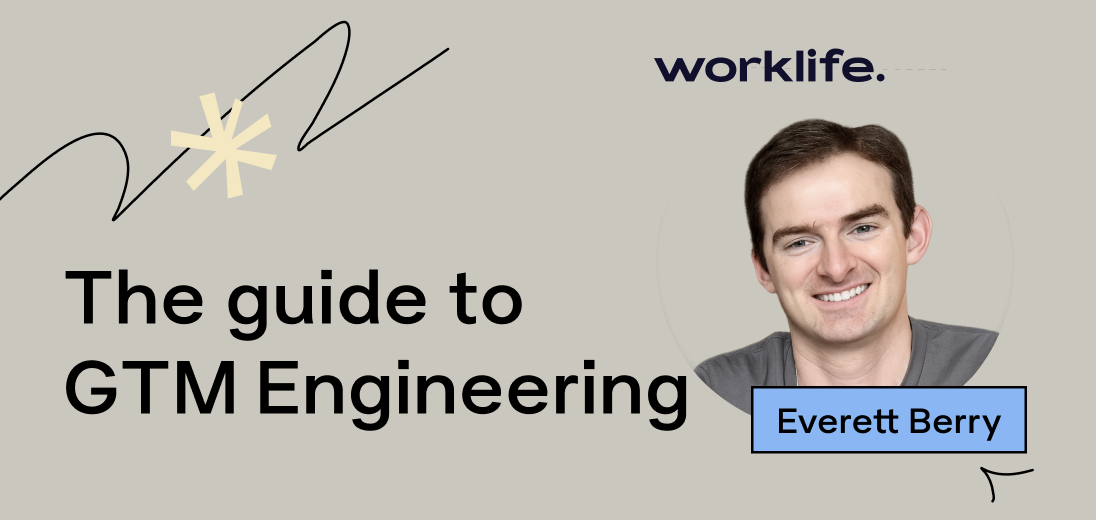When Clay raised their Series C, they described GTM Engineering to The New York Times as "one of the first AI-native jobs." It's a bold claim—but one that's increasingly proving true. This isn't just another buzzword for sales operations or revenue operations with a fresh coat of paint. GTM Engineering represents a fundamental reimagining of how companies identify, reach, and convert customers in an AI-powered world.
In a recent conversation with Worklife founder Brianne Kimmel, Clay's Head of GTM Engineering Everett Berry shared insights into how this function works, why it's critical for modern companies, and how startups and established businesses alike can build their own GTM engineering capabilities.
Sales Teams Drowning in Low-Leverage Work
Ask any sales rep what they love most about their job, and they'll tell you: talking to customers. Building relationships, understanding needs, solving problems—that's where the magic happens.
But ask them how they spend most of their time, and you'll hear a different story:
- Sourcing contacts manually
- Writing personalized outreach messages
- Researching companies and accounts
- Prioritizing endless lists of prospects
- Cleaning data in the CRM
These tasks are technically "owned" by sellers, but in reality, they're often neglected or done poorly due to bandwidth constraints. The result? Atrophying pipelines, increased ad spend, and the brute-force solution of hiring more SDRs.
The central insight of GTM Engineering: What if we could centralize these tasks with a specialized team armed with high-leverage AI tools?
What is GTM Engineering?
GTM Engineering is the practice of using AI-powered tools and systems thinking to automate and optimize the entire go-to-market function. It's a role that literally couldn't exist without modern AI capabilities—you simply cannot generate creative messaging at scale, clean and research companies comprehensively, or stitch together complex qualification logic without powerful models.
The Three Core Principles
1. Centralization Creates Leverage
By consolidating GTM tasks into a small, specialized team, companies can:
- Free sellers to focus on high-value customer conversations
- Apply consistent methodology across all outreach
- Build institutional knowledge about what works
- Operate AI tools more effectively than distributed teams
- Think ahead to moving up market to enterprise ie: WorkOS enables PLG companies to sell into enterprise
At Clay, a small tiger team of GTM engineers does work that would traditionally require dozens or even hundreds of people across multiple functions.
2. Experimentation Unlocks "GTM Alpha"
In finance, "alpha" refers to returns above the market benchmark—your edge over the competition. GTM Alpha is the same concept applied to go-to-market.
When you centralize control over personas, accounts, and messaging, you can run rapid experiments to discover unique insights about your market.
Case study: Intercom and Fin
Intercom used Clay to experiment with different account types and personas for their AI customer support tool, Fin. Through systematic testing, they discovered secrets about their ideal customer profile that helped them—an incumbent—take the lead against newer AI-native competitors. In a space where Intercom could have been seen as "legacy software," they instead became the category leader.
3. Continuous Edge Discovery is the Real Edge
Here's the uncomfortable truth: All go-to-market tactics expire.
What's worse? In the AI era, they expire faster than ever before. Tactics that used to work for years now become commoditized in months. Job change alerts? Everyone's doing them. Basic personalization? Table stakes.
The tooling has made executing basic tactics trivially easy, which means everyone quickly adopts them, and they stop being differentiators.
The real competitive advantage isn't finding one tactic that works—it's building a system that continuously discovers new edges.
This is only possible with a centralized team using high-leverage AI tools that can automate frontline sales and marketing work while freeing up capacity for experimentation.
The Golden List: Your Foundation
For early-stage companies building GTM engineering capabilities, there's one clear starting point: The Golden List.
What is the Golden List?
The Golden List is a dynamic, continuously updated database of your ideal customer accounts and contacts. Even mature companies often lack this fundamental asset.
Key components:
- Top accounts currently in your addressable market
- Tiered segmentation (Tier 1, 2, 3 based on fit and potential)
- Contact grading (A through F based on buying influence)
- Regular updates as companies grow, pivot, or enter your ICP
Why It Matters: The Dinner Test
Imagine your founder is traveling to San Francisco in two weeks. They want to host an executive dinner with your primary VC. They ask you: "Who are the top 20 executives I should invite?"
For most companies, this is hours of work. You're asking AEs, checking Salesforce, cross-referencing LinkedIn, verifying contact info, debating who's really qualified.
With a proper Golden List, it's a single query: "Top open opportunities in San Francisco, grade A or B contacts at VP level or above." Done. You have your list with accurate contact information, ready to email or message on LinkedIn.
This dinner invite scenario is actually a litmus test for how good your Golden List is.
The Cursor Example
When Clay first encountered Cursor, they didn't meet the ICP criteria. Two months later, they did—their revenue and complexity had grown substantially. Because Clay had the infrastructure to continuously update their Golden List, Cursor was automatically identified and prioritized.
This responsiveness to market changes is impossible without systematic, automated data management.
Beyond B2B: Expanding Your Aperture
One of the most valuable insights from building a Golden List is discovering non-obvious customer segments.
Clay realized that companies like DoorDash, Airbnb, and Uber—while not traditional B2B companies—had teams sourcing businesses for their two-sided marketplaces. These teams were doing exactly the same work that demand gen or rev ops teams do, just for a different purpose.
Result: Clay built a list of 250 marketplace companies almost overnight and began targeting them systematically.
Other examples:
- Duolingo (consumer app) sells learning & development solutions to global enterprises
-
The lesson: Every venture-scale business has some iteration of a sales function. Don't limit yourself to traditional B2B thinking.
How to Structure Your GTM Engineering Team
Clay treats GTM Engineering like a product organization, and you should too.
The Operating System
Bi-weekly sprints with release notes covering:
- Data quality improvements
- New campaigns launched
- New automations developed
- Signal experimentation results
- Tool integrations
Linear board for tracking all projects and priorities
Slack ticket queue for submitting requests from:
- Leadership
- Sales reps
- Marketing teams
- Anyone with insights or needs
Analytics tracking to measure:
- Internal tool adoption
- Field engagement with GTM assets
- Which automations are actually being used
Why This Matters
Most companies invest in sales tooling that doesn't get used. They have anecdotal evidence of low adoption but don't know why or which parts are failing.
By treating GTM engineering as a product discipline with proper tracking, you can:
- Identify what's working and double down
- Kill what's not working quickly
- Capture feedback systematically
- Iterate based on data, not opinions
Hiring Your First GTM Engineer
The GTM Engineering role requires a unique combination of skills. Here's how to evaluate candidates:
Foundation: Systems Thinking (Good)
At a fundamental level, GTM engineers need to think programmatically—"if this, then that" logic.
Why it matters: 95% of AI initiatives fail because people don't understand how systems interact.
Example: If you send a contact from Clay to Outreach, it needs to sync with Salesforce first, or the campaign won't work. Clay doesn't control when Salesforce syncs with Outreach—that happens outside its purview. You must set up Clay with this integration detail in mind.
Backgrounds that work well:
- Ex-consultants
- Financial analysts
- Growth and ops people (used to working in Google Sheets)
- Successful BDRs/AEs with computer science degrees
Note: You don't need to be a programmer, but you need to understand systems and workflows.
Business Acumen: Understanding the Field (Great)
Technical skills get you in the door. Business understanding makes you valuable.
What separates good from great:
- Understanding what the business actually needs and why
- Knowing why certain approaches work and others don't
- Experience carrying a pipeline number or selling in-seat
- Ability to do seller ride-alongs and understand day-to-day workflows
Many rev ops teams are disconnected from actual seller workflows. The best GTM engineers have field-level understanding that allows them to design systems sellers will actually use.
Product Ownership: Treating GTM as Your Product (Amazing)
The top tier of GTM engineers think like product owners:
- They own the roadmap for GTM systems
- They're responsible for end-to-end implementation
- They treat GTM as their product and continuously improve it
These are 10X employees. You should pay them as well as your best engineers because they'll be directly or indirectly responsible for tens of millions in revenue.
Interview Red Flags
Beware of candidates who:
- Can't explain how different tools integrate
- Haven't talked to sellers or customers recently
- Think tactically but not systematically
- View GTM engineering as just "rev ops with AI"
Implementation Roadmap: From Zero to GTM Engineering
Whether you're an early-stage startup or an established company, here's how to build GTM engineering capabilities:
For Early-Stage Companies: Start with the Golden List
Week 1-2: Build your initial Golden List
- Identify your top 500-6,000 target accounts
- Segment into tiers (1, 2, 3)
- Grade contacts (A-F based on buying influence)
- Enrich with relevant data points
Week 3-4: Set up automated updates
- New companies entering your ICP
- Existing companies growing into your ICP
- Contact changes (job moves, promotions)
- Trigger events (funding, expansion, hiring)
Month 2: Start acting on the list
- Build targeted campaigns for Tier 1 accounts
- Create account-based plays for grade A contacts
- Test the "dinner invite" scenario
- Measure time from insight to action
Month 3+: Iterate and expand
- Capture insights from successful deals
- Identify new segments (like Clay's marketplace discovery)
- Experiment with messaging and channels
- Build your first automated workflows
For Established Companies: Start with Data Quality
Most established companies have a painful truth to face: data quality degrades over time.
Reps tell you they can never reach people on the phone. You're not confident about territory assignments. Your industry segmentation doesn't match how you actually think about the market.
Phase 1: Industry Segmentation (Month 1)
Start with a project that doesn't disrupt existing workflows: properly segment your accounts by industry and sub-industry.
Most companies have bespoke views of their market that don't map to LinkedIn or ZoomInfo's standard categories. At Clay, they segment tech into 12 specific categories plus non-tech. This classification drives everything else.
Why start here:
- Can be done entirely within Clay + your CRM
- Doesn't require seller involvement
- Builds confidence in the system
- Clarifies organizational thinking about ICP
- Creates foundation for all future work
Phase 2: Targeted Campaigns (Months 2-3)
Once data quality improves, start building campaigns:
- Begin with SMB or mid-market segments (lower risk)
- Send messaging to sellers for review before automating
- Gather feedback and iterate
- Build trust gradually
Phase 3: Automation (Months 4-6)
Take it piece by piece:
- Automate first touch outreach
- Automate LinkedIn messages
- Automate phone talk tracks
- Gradually expand automation based on results
Key insight: Even if you never reach full automation, improved data quality will enhance everything built on top of it. Your existing campaigns will perform better. Your sellers will be more productive. Your pipeline will be healthier.
The Competitive Landscape: Why Speed Matters
The go-to-market landscape is accelerating, and not in a good way for companies moving slowly.
The Expiration Curve is Steepening
Tactics don't just expire—they expire faster than ever:
Old world: A tactic might work for 2-3 years before becoming saturated
New world: A tactic might work for 6-8 months before everyone's doing it
Why: AI tools have democratized execution. What used to require sophisticated operations can now be done by anyone with access to the right tools.
The 8-Month Rule
If you discover something that's working, start the clock. In 8 months, you need a "next best alternative" ready to go.
This means:
- Continuous experimentation is non-negotiable
- You can't rest on a successful playbook
- The real edge is your ability to find new edges
- Companies need to diversify pipeline sources earlier than ever
The Cursor Case Study: Speed to Market
Cursor went from being a PLG product for students and individual developers to Jensen Huang (NVIDIA's CEO) calling it his favorite enterprise application—in less than a year.
While Cursor deserves enormous credit for their product and execution, their go-to-market transformation demonstrates what's possible when you:
- Stay hungry even when you're already winning
- Target correctly and move upmarket deliberately
- Iterate faster than the market expects
Beyond Traditional B2B: Expanding Your Market Aperture
One of the most valuable capabilities of GTM engineering is identifying non-obvious customer segments.
The Marketplace Insight
When Clay closed deals with DoorDash, Airbnb, and Uber, these companies weren't on their initial target list—they're consumer companies, not B2B.
But they all have two-sided marketplaces where it's critical to source businesses and demand. The teams doing this work—even though they're not "sales" teams—do exactly the same job as demand gen or rev ops teams supporting traditional sales orgs.
The action: Built a list of 250 marketplace companies and started targeting them systematically. This happened almost overnight because the infrastructure was in place.
Consumer Companies with B2B Arms
- Duolingo: Massive consumer success story, but also sells learning & development solutions to enterprises with global operations
- Cursor: Started with individual developers, now selling to enterprise
- WorkOS: Enables PLG companies to add enterprise features
The pattern: Every venture-scale business has some iteration of a sales function. It might be:
- Advertising sales teams
- Supply-side growth teams
- Demand-side growth teams
- Partnership development
- Enterprise add-ons to consumer products
Why GTM Engineers See This First
Field sales reps often have these insights: "Hey, we should target marketplace companies."
The problem? In most organizations, these insights are either:
- Known but not acted upon (bandwidth issues, process bottlenecks)
- Not captured systematically (lost in Slack, never prioritized)
The GTM engineering model solves this by:
- Creating clear channels for insight submission (Slack → Linear)
- Having dedicated capacity to act on insights quickly
- Reducing time from insight to action (days, not quarters)
The most frustrating conversation: Talking to an ops team about a "new" initiative they're working on, then talking to the top rep who says, "I told them about this six months ago."
The Future: What's Next for GTM Engineering
As we look ahead, several trends are shaping the evolution of this function:
1. GTM Engineering as a Career Path
More professionals are asking: "What roles give me firsthand visibility into all the new AI tools coming to market?"
GTM Engineering is emerging as the answer. It's becoming a sought-after position for people who want to:
- Work at the intersection of AI and business
- Have high impact with high autonomy
- Build new systems rather than maintain old ones
- Develop skills that will be valuable for decades
2. Earlier Diversification of Pipeline Sources
Companies used to follow a predictable path: PLG → inbound → outbound → enterprise.
Now, the best companies are diversifying earlier:
- PLG companies adding outbound motions in year one
- Enterprise tools launching with product-led growth
- Consumer companies building B2B arms simultaneously
GTM engineering enables this diversification by making it operationally feasible to run multiple motions without proportionally scaling headcount.
3. The Narrative Advantage
Companies that invest in GTM engineering are creating a narrative advantage in hiring and partnerships.
When you can say "we have a dedicated GTM engineering function," you're signaling:
- We're thinking about AI seriously
- We're building for the future, not the past
- We have our operational house in order
- We're a place where ambitious people can learn cutting-edge skills
Clay is experiencing this firsthand—startups reach out specifically to learn about their GTM engineering function, which creates opportunities for partnerships, hiring, and thought leadership.
4. The Retention Question
Many fast-growing PLG companies are crushing it on growth metrics but face questions about medium-term retention.
The challenge: How do you strategically grow existing accounts to make them "meatier" and more enduring?
The answer: GTM engineering that spans not just acquisition but also:
- Expansion and upsell
- Cross-sell into new use cases
- Customer success automation
- Retention signal detection
The same principles that work for finding new customers work for growing existing ones—you just need the data, systems, and experimentation mindset.
Common Pitfalls and How to Avoid Them
Pitfall #1: Treating GTM Engineering Like Traditional Rev Ops
The mistake: Hiring for GTM engineering but expecting traditional rev ops deliverables
Why it fails: Rev ops is often reactive and focused on maintaining systems. GTM engineering is proactive and focused on finding new edges.
How to avoid it:
- Set clear expectations around experimentation
- Measure success by new insights discovered, not just systems maintained
- Give GTM engineers space to try things that might fail
Pitfall #2: Not Connecting to the Field
The mistake: Building sophisticated systems that sellers don't use
Why it fails: Without field-level understanding, you optimize for theoretical efficiency rather than practical effectiveness
How to avoid it:
- Require GTM engineers to do seller ride-alongs
- Create feedback loops from field to operations
- Track adoption metrics religiously
- Kill unused tools quickly
Pitfall #3: Boiling the Ocean
The mistake: Trying to automate everything at once
Why it fails: Change management, technical complexity, and organizational resistance compound
How to avoid it:
- Start with data quality (especially for established companies)
- Pick one segment (SMB/mid-market) for initial campaigns
- Automate one channel at a time
- Build confidence through small wins
Pitfall #4: Ignoring the Expiration Curve
The mistake: Finding one tactic that works and riding it indefinitely
Why it fails: Tactics expire faster in the AI era; competitors copy quickly
How to avoid it:
- Set 8-month timers on successful tactics
- Always have experiments running for "next best alternatives"
- Treat continuous experimentation as non-negotiable
- Build organizational muscle for rapid pivots
Pitfall #5: Underinvesting in the Function
The mistake: Treating GTM engineering as a junior role or paying below market
Why it fails: Top GTM engineers are directly responsible for millions in revenue; underpaying means you get junior talent handling critical functions
How to avoid it:
- Pay top GTM engineers comparably to top software engineers
- Give them ownership and autonomy
- Recognize the 10X potential of great hires
- Invest in tools and resources
Conclusion: The Competitive Imperative
GTM Engineering isn't just a nice-to-have for innovative companies. It's rapidly becoming a competitive requirement.
The companies that will win in the next decade:
- Find GTM edges faster than competitors
- Act on field insights in days, not quarters
- Maintain high-quality data as a foundational asset
- Free their best sellers to do what they do best: sell
- Experiment continuously rather than executing playbooks
The companies that will struggle:
- Rely on tactics that worked last year
- Leave GTM innovation to individual sellers
- Let data quality degrade over time
- Treat AI as a tool rather than a transformation
- Move slowly from insight to action
The good news? The playbook for building GTM engineering capabilities is clearer than ever:
- Start with your Golden List (early stage) or data quality (established companies)
- Hire for systems thinking + business acumen + product ownership
- Treat GTM like a product with sprints, releases, and analytics
- Experiment continuously to find and maintain edges
- Move fast from insight to action
The AI-native job of GTM Engineering is here. The question isn't whether your company needs this function—it's whether you'll build it before your competitors do.
Want to learn more about building GTM engineering capabilities at your company? The best place to start is with your data. Build your Golden List, segment your market properly, and create the foundation for everything else that follows.





